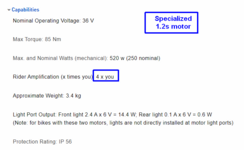I have a Creo and the motor is rated for a maximum output of 240 watts, while the battery is rated at approximately 330 watt-hours. I was trying to make sense of the tuning parameters (Eco/Sport/Turbo and the associated values) as described within the Specialized literature and how the various settings impact range (miles) on the bike. There are two values for each setting, Support and Peak. Specialized described how these “work”, but it just wasn’t making perfect sense. The Peak setting is easiest for me to understand, it is the most power produced by the motor and is found by multiplying the setting value by the maximum output rating of the motor. In the case of Eco with the default setting of “35”, 240w times 0.35 = 84 watts. When on the 35%setting, the motor has a ceiling output of 84 watts. However, to get the motor to put out the maximum 84 watts, you (the person) must pedal and generate 240 watts. If the person generates 240 watts, then the motor adds and additional 84 watts for a total power of 324 watts. If a person generates more than 240 watts, the motor is capped at 84watts (in the Eco setting of 35). The Support value is a bit more confusing, but this is how I interpreted it to work. If the person generates 100 watts of power, and the support setting is 35 (again the default setting for Eco), the motor provides 35 watts of power (100w times 0.35). This provides a total power of 135 watts. Here is a table for the default 35/35 Eco Setting:
Power Meter (legs) Motor Power (machine) Total Power
100w 35w 135w
150 52.5 202.5
200 70 270
240 84 (max) 324
300 84 384
I am assuming the Power value that is being shown on my Garmin head unit data field is the power being generated by me and does NOT include the additional power from the motor.
Getting to the range issue. The battery is rated at approximately 330 watt hours. With a peak output of 84 watts at the Eco setting of 35, second value in the 35/35 setting), the battery would last 330/84=3.9 hours. This assumes a full charge with a linear discharge, and the person generates at least 240watts on their own. If all of this is correct, the question is how far can I go? That depends on the average speed over that 3.9 hours. If the average speed is 20 mph, then the range would be 78 miles. If the power is held constant, the speed would vary due to headwind, gradient, etc.
With the maximum output limited to 35%, you should be able to get nearly 4 hours of riding. Does this make sense? Sorry for the long and maybe confusing post, just trying to make sense of the tuning settings and how they impact range.
Power Meter (legs) Motor Power (machine) Total Power
100w 35w 135w
150 52.5 202.5
200 70 270
240 84 (max) 324
300 84 384
I am assuming the Power value that is being shown on my Garmin head unit data field is the power being generated by me and does NOT include the additional power from the motor.
Getting to the range issue. The battery is rated at approximately 330 watt hours. With a peak output of 84 watts at the Eco setting of 35, second value in the 35/35 setting), the battery would last 330/84=3.9 hours. This assumes a full charge with a linear discharge, and the person generates at least 240watts on their own. If all of this is correct, the question is how far can I go? That depends on the average speed over that 3.9 hours. If the average speed is 20 mph, then the range would be 78 miles. If the power is held constant, the speed would vary due to headwind, gradient, etc.
With the maximum output limited to 35%, you should be able to get nearly 4 hours of riding. Does this make sense? Sorry for the long and maybe confusing post, just trying to make sense of the tuning settings and how they impact range.

